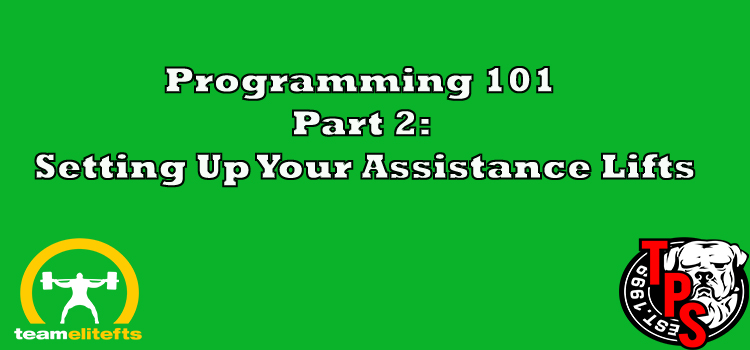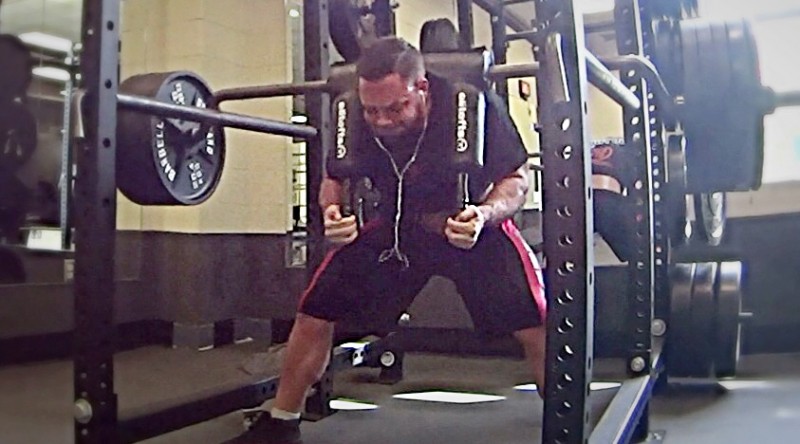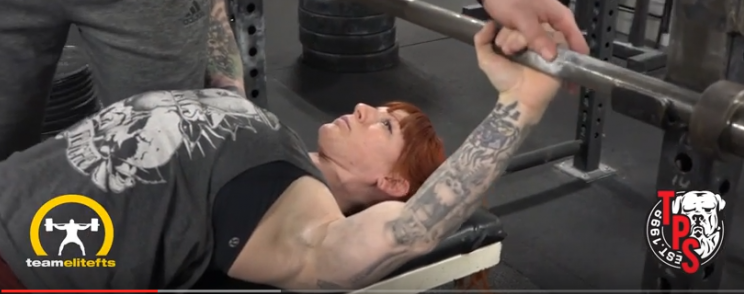
I was on the phone with Dave Tate the a few weeks ago and he asked me what I was doing.
I said that I was generating top quality content for his website, which I was. I was writing Programming 101 Part 1, which I thought was good content.
I said to him I think it’s funny, the logs I write that I think are my best ones, the ones I work on for hours, don’t seem to get read as much as the ones I smash out when pressed for time.
Might be the titles, might be that what I think is good isn’t.
Anyway.
In the first installment of Programming 101 I went over setting up your main movement for the day.
Today, I’ll go over the second movement.
The Assistance work.
Let’s clarify what Assistance and Accessory work is.
Assistance work is an exercise done to build the Squat, Bench Press or Deadlift.
It can be a variation of one of the three, or something different. The point is that it is to build the lift, to make it strong(er).
Accessory work is your repetition work, bodybuilding stuff, prehab, rehab and so forth.
Accessory work builds muscle and makes you strong(er).
Now with that 100% unscientific explanation out of the way let’s go over how I choose Assistance work.
This will change if you are programming for an individual or for a group.
I’ll go over how I program for a group first and then briefly explain the individual. I am doing it this way because it will illustrate how to do it for an individual pretty clearly.
Programming for a group isn’t that hard, but a lot people think it is.
When programming for a group you can’t personalize it, but you can address all of the most common flaws that will arise in the three lifts.
All you need to do is program your Assistance lifts accordingly and in conjunction with your primary lift.
A sample template may illustrate it better, so here is a sample Squat/Deadlift wave:
NOTE:
In my programs we typically do Squats on Day 1 and then a Deadlift builder as Accessory.
On Day 3, we Deadlift and do a Squat Builder as Accessory.
It's similar on Bench days, except that we bench and do bench/pressing builders.
| Week 1: | Day 1-Squat | Day 2-Deadlift |
| Main: Safety Bar Squat
Accessory: 2” Block Pull |
Main: 1” Deficit Deadlift
Accessory: Paused Front Squat |
|
| Week 2:
|
Same exercises, change %/RPE
and reps |
Same exercises, change %/RPE
and reps |
| Week 3:
|
Main: Squat with Chains
Accessory: Opposite Deadlift |
Main: Deadlift with Chains
Accessory: Safety Bar Good Morning |
| Week 4:
|
Same exercises, change %/RPE
and reps |
Same exercises, change %/RPE
and reps |
| Week 5: | Main: Paused Squat
Accessory: Low Box Squat with Chains |
Main: Paused Deadlift
Accessory: Close Stance Belt Squat |
| Week 6: | Same exercises, change %/RPE
and reps |
Same exercises, change %/RPE
and reps |
Looking at this chart, we can see that the main lifts and the accessory lifts address common flaws for most lifters, not all, but you can’t hit everything in a snapshot of a program like this.
Here is the ‘splaining of how this works:
Week 1 & 2, we have Safety Bar Squats, inarguably an outstanding variation of the squat for all lifters. If you are a reader of this site, you know the value of them.
And YES, they are effective for Raw and Equipped lifters. Why this is a discussion or an argument these days I will never know.
Our second lift in Week 1 is 2” Block Pulls, and that is our Deadlift builder.
2” Block Pulls focus on the most difficult part of the pull for many, right around low to mid-shin.
Building strength here will pay off for everyone, even if it is not your individual weakness.
In Week 1 & 2, Day 2, we have 1” Deficit Deadlifts. Deficits build your strength off the floor, and I don’t care how strong you are, you can always be stronger off the floor.
Note: I generally don’t use much greater than a 2” deficit most of the time, some use a larger one and that is fine. Whatever works for you. I’m not a fan of the “my way is the only way” line of thinking.
Our second exercise is the Paused Front Squat. These are a favorite Deadlift builder of mine, but they work well for the Squat too.
There is a metric shit ton of quads involved as well as erectors. Getting strong on these will benefit the vast majority of the lifting population.
Moving on to Weeks 3 & 4, we see Squat with Chains as the main lift on Day 1.
Squatting with chains is excellent for many reasons including:
- Adding overload at the top
- Building speed
- Managing intensity
- Reinforcing positioning (being able to stay in the proper positions at each point of the lift)
Our second exercise is Opposite Deadlifts.
Opposite Deadlift are simple, if you normally pull Sumo, do conventional, and vice versa.
Pulling in your opposite stance recruits the muscles in a different way and build your normal movement by strengthening areas not normally used.
Again, it is a great fit for just about everyone.
Day 3, Deadlift day has us doing Deadlift with Chains as the primary movement.
We all know the benefits of training with chains right?
Our Accessory lift is Safety Bar Good Mornings.
Arguably one of the best Accessory lifts for both the Squat and Deadlift. There is some crossover on the Accessory lifts as many build both lifts, in fact, most do.
Safety Bar Good Mornings build a supper strong lower back, ass and hamstrings. The build your deadlift effectively by strengthening the entire backside of the body.
They are great for Squats too because the same muscles are used, albeit in a slightly different way, and having a huge Good Morning can save a Squat that starts to dump.
Moving to Weeks 5 & 6, we see Paused Squats as the primary lift on Day 1.
Paused Squat are another favorite variation of mine with pauses ranging from 1 to 5 seconds.
Pause Squats assist in:
- Speed out of the hole
- Positions
- Mental toughness
- Technique correction/perfection
Our Accessory lift on Day 1 is Low Box Squat with Chains.
These are a tremendous deadlift builder, and they help the Squat too. See the crossover?
Low Box Squats, at least 1” below comp depth, but more is a little better, maybe 2” if you can control positions, smash the posterior chain.
Smashing the posterior chain makes it stronger.
A stronger set of hamstrings, glutes and erectors means a bigger deadlift.
Raw or equipped.
RANT:
Remember, when choosing exercises, you need to know why you are doing them. Some coaches say that many of these exercises only work for equipped lifters and I feel they are missing the point.
Strength is strength.
Getting strong(er) is getting strong(er).
Using an exercise that you chose FOR A REASON works regardless of whether you lift Raw or Equipped, they work whether you lift USAPL, USPA, XPC, RPS or any of the other ingredients in the powerlifting alphabet soup.
Simply thinking “That’s for multi ply lifters” is short sighted.
So is tossing in random exercises, you’ve got to have a reason for adding them in.
RANT OVER
Let me get back on track, I tend to digress sometimes….
Wek 5 & 6 Day 3, Deadlift Day has Paused Deadlifts. Some like them, some don’t.
I do.
Paused deadlifts work wonders for reinforcing proper positioning just off the floor.
This is a spot where many lose position and miss the lift. When doing these, it is critical to remember why you are doing them.
To reinforce good positions. This makes you stronger, which allows you to lift more.
Simple.
Not easy.
Our Accessory lift this day is Close Stance Belt Squats.
These are quad killers.
Making your quads strong(er) seems like a reasonable concept for those of us who want to Squat more weight right?
So, there is a simple explanation of how I choose Assistance work for groups.
I program for the most common flaws that we see in each lift, and equally as important, I program to build specific positions on each lift.
Squat:
- Out of the hole
- Mid point
- Lockout
Bench Press:
- Off the chest
- Low end
- Mid range
- Lockout
- Plus: Maintaining proper arch and upper back positions
Deadlift:
- Off the floor
- Mid shin
- Lockout
When designing a program, you need to consider all of these things, and address them in your training blocks.
We may focus on one area primarily each lift and each block or focus on one for a few weeks and then move on to another.
It all depends on what the goal of the block is and where we are in the competition schedule.
You also need to make sure the program is symbiotic with itself.
Your main lift and your accessory lifts should all be in sync and not randomly tossed in.
Your sets, reps and weights (percentages/RPE) should also be aligned.
For example, if you are in a volume block, having your athlete use heavy band tension on an accessory lift may interfere with recovery and other factors.
On the same idea, if you are in an intensity block and they are using high percentages/RPE’s on the main lift, and you overload them on Assistance and Accessory work, you’ll be in a sinking boat.
It’s a balancing act, and you have to be a master of your tightrope.
Now, a word on programming for an individual.
Our example above is a snapshot in time of how I would program for a group.
This could just as easily be for a specific individual if their specific needs aligned with the program listed.
What you need to keep in mind when programing for an individual, is that you need to take their personal strengths and weaknesses into account.
Let’s say that you have a lifter who has a good bench press and is super strong at lockout, I mean super strong.
But, they struggle mid-way through the lift and lose it.
Having them do a lot of high board work will probably not address their issue and may actually reinforce the weakness.
This falls back to when I said that you need to have a reason for doing things.
I remember years ago that Alwyn Cosgrove said all of his employees had to be able to give him a reason for what they were doing.
If they couldn’t, they were fired.
He also said that if they gave him an answer and it was wrong, he didn’t care, they had a reason.
If they were wrong, he would simply train them better so they would be right next time.
Cosgrove is a pretty smart dude.
In future installments of Programming 101, I’ll go over Accessory programing, how to choose sets and reps for Assistance and Accessory work and more.
I hope you like this and that it helps.
If you do, leave a comment, or ask a question.
I’m here to help.
And the Broads have another new podcast out.
Check out our TPS Method for Powerlifting ladies and their podcast:
Broads with Quads.
It's really good.
This week they rant a little about stuff that irks them.
Ask me a question-Be sure and Type to Murph in the header
Find me on Google-search for Total Performance Sports Malden, Mass. The Best Gym in Boston, Facebook too.
Oh, yeah, follow us on Instagram too. TPSMalden
SHARE THIS!
#bostonsstrongest
Vincere vel mori
C.J. Murphy
March 8, 2018














Thanks for reading and the comment.
I'll try to keep it up.
Vinceri vel Mori